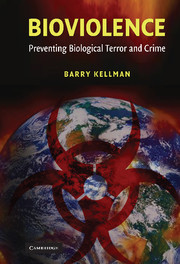Book contents
- Frontmatter
- Contents
- Prologue
- Foreword, by Ronald K. Noble, Interpol Secretary General
- Acknowledgments
- Introduction
- PART I THE BIOVIOLENCE CONDITION AND HOW IT CAME TO BE
- 1 Why Worry?
- 2 Methods of Bioviolence
- 3 Who Did Bioviolence? Who Wants to Do It?
- PART II THE GLOBAL STRATEGY FOR PREVENTING BIOVIOLENCE
- Conclusion
- Notes
- Bibliography
- Index
3 - Who Did Bioviolence? Who Wants to Do It?
Published online by Cambridge University Press: 27 July 2009
- Frontmatter
- Contents
- Prologue
- Foreword, by Ronald K. Noble, Interpol Secretary General
- Acknowledgments
- Introduction
- PART I THE BIOVIOLENCE CONDITION AND HOW IT CAME TO BE
- 1 Why Worry?
- 2 Methods of Bioviolence
- 3 Who Did Bioviolence? Who Wants to Do It?
- PART II THE GLOBAL STRATEGY FOR PREVENTING BIOVIOLENCE
- Conclusion
- Notes
- Bibliography
- Index
Summary
The subject of bioviolence inevitably leads to the question: who would do such a repulsive thing? Some experts argue that terrorists and rogue States are not interested in bioviolence – the threat might therefore be overblown. Hopefully, they are correct. An enormous amount of evidence, however, suggests they are wrong.
Here's the dirty truth: from the dawn of biology's ability to isolate pathogens, people have pursued hostile applications of disease. To ignore this extensive history and presume that today's villains are not fervent about weaponizing disease is very dangerous. As bioviolence becomes easier and more lethal, we ignore this penchant for making people sick at our peril.
The first section of this chapter portrays the historical experience with biological weapons. The second section focuses on existing State bioweapon programs. The final section turns to terrorist and fanatic bioviolence – today's most critical threats.
THE BIOLOGICAL WEAPONS EXPERIENCE
Disease has been entwined with war and violence for millennia. Plagues inflicted on Egyptians compelled the Exodus. Greek swordsmen coated their blades with feces. Tartar besiegers of Caffa – a port city on the Black Sea – hurled plague-ridden corpses over city walls possibly beginning the Black Death that killed almost one in three Europeans. Centuries later in the American colonies, General Jeffrey Amherst, commander of British forces at Fort Pitt, responsible for “the Total Extirpation of those Indian Nations,” gave blankets previously worn by smallpox patients at nearby hospitals to Native Americans.
- Type
- Chapter
- Information
- BioviolencePreventing Biological Terror and Crime, pp. 55 - 84Publisher: Cambridge University PressPrint publication year: 2007

